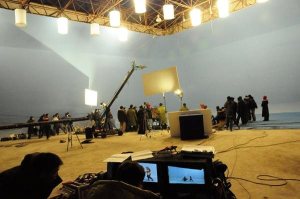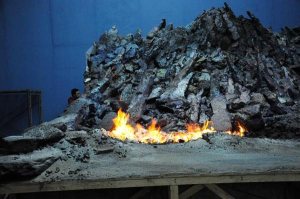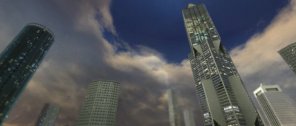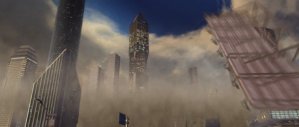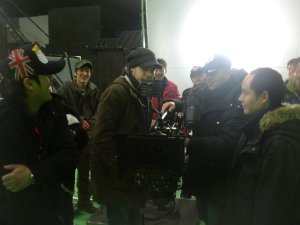Latest
VFX Talk Thread about the Chinese VFX Scene
Xi You Ji – Monkey King TV Series
Bubble Gum Crisis Wrap Up
Bubble Gum Crisis Trailer
At this moment we are dead busy with a trailer for Cannes. Bubble Gum Crisis is a successful Manga TV series which has been airing worldwide for the last 20 years. Now the Japanese copyright owners decided to make a feature film adaptation and try to sell the whole package at the Cannes Film festival this year. Since time is short, resources limited we had to very careful explore all the options available in letting this to become a reality. We have been brought in at the conceptual stage where the actual designs and the transition from 2D to 3D and further to real characters were not even decided. The production and the conceptual stage are running in parallel which means a logistical nightmare for the pipeline as models, animations, textures have to be constantly tweaked to address the wishes of our client and to ensure that the fan community will get what they would expect from a comic (Manga) adaptation. Our pipeline consists of Mental Ray for preview renders, Renderman Studio for final renders, Nuke for compositing, Maya for modeling and animation, Z-Brush for texturing, 3DSMax (Fume FX) for Particles and Houdini for FX animation. We’ve adopted the Open EXR standard for rendering and compositing and are pretty happy not to run into significant problemsuntil now.
Below you can see some production stills from the shooting with RED One and our ‘garage’ studio setup. The overall timeframe is 3 month from conceptual design to delivery. For a 1,5 min long trailer a pretty tight schedule… But hey, it wouldn’t be us if it would be easy !!
RED ONE SHOOTING
This one is special for me… i shot the first time with RED and even there are voices against that it can’t hold up to Genesis, F23 or others, i must say i am seriously impressed with the 4K resolution (i know just 3,2) and its nearly grain-free appearance. We shot 4K 2:1 to down sample to 2K 2:1 and after a simple one-light treatment in Cine Red (which is BTW impressive too) exported as DPX sequence to further do the final comp in Shake. I was a little bit puzzled first to be able to change basically everything from sensitivity (ISO/ASA) to White Balance, Tint, Temperature, etc. but once you get the concept of RAW it is pretty simple to get the a ‘look’ out of the box. Indeed a really geeky thing what RED throw on the market and for sure not everyone’s thing to take over the ‘colorist’s’ job as it necessitates more than just pushing buttons and a deeper understanding of the whole post-work-flow down the road, but for people who love ‘total control’ a heavenly dream came true.
For me for sure not the last time and we are hopefully soon going to shoot everything from TV-commercials to TV-movies and maybe act as second unit for feature films. Especially for cost-effective VFX shots RED is from now on my choice. Anyway, i want buy Scarlet when available and i am a huge fan of RED ONE, even if there are still some people concerned about reliability and matureness of such a system. For geeks like me who want be involved in the evolution of a revolutionary new digital cinema format definitely the right (RED) thing !!!
Nuke 5.2
OK, so now that i have got Nuke 5.2 and just finished my first comp, where i was using the 3D environment to displace a camera-mapped image to simulate footsteps of a guano, i must say that i really like Nuke’s channel architecture even though i think i am still much faster in Shake to these comps with a lot of separately rendered passes. Maybe because of the clarity of piping just in the mask layer for certain operations, which can be done of course in Nuke as well, but in the moment we rendered OpenEXR’s files it was sometimes confusing to choose the right control layer, you always have to switch back and forth to see what the actual layer was, whereas in Shake it was much faster to see which layer is used to restrict a certain operation. I think it is just a workflow thing and i have to get used to, BUT the rest i pretty much liked especially the 3D environment.
We will also soon open a NUKE course here at IDD (www.iddcg.cn) which i will teach besides my successful Shake course and also help Base FX (www.base-fx.com) to make a smooth transition from Shake to NUKE.
The BEST will win…
So here we go, what should i say: a cool loft in Chaoyang district, i am their VFX Supe and Lead Comper with another 120 !! folks, doing tests for Rainmaker, The Orphanage and others, pretty impressive what kind of transformation company XXX went through in the last year, nobody probably expected to see that kind of work from China, at least not from Chinese guys, BUT if their US clients are already afraid of loosing their core business to China than they must be on the right track to gain international recognition and i am somehow one of the reasons to give them a more competitive edge.
Here are screenshots from my tests i have done for Rainmaker:
1. original live plate 2. jaw removed 3. CG jaw (face) replacement
I did the jaw removal and comp in Shake, facial tracking with rough gemometry in PFTrack and the animation and fur was done by company XXX (Shave and a Haircut) in Maya.

























